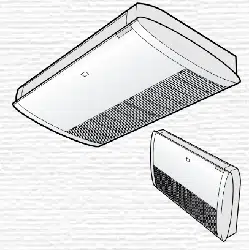Loading ...
Loading ...
Loading ...

SWING
FAN
MODE
SET/C
1h
Press the THERMOSTAT button to set the
desired temperature.
• In the AUTO and DRY
modes, the tempera-
ture can be changed
in 1°C increments
within the range of 2°C
higher to 2°C lower
from the temperature
automatically deter-
mined by the air con-
ditioner.
• In the COOL and HEAT modes, the tempera-
ture can be set within the range of 18 to 32°C
1
E-8
BASIC OPERATION
2
Press the ON/OFF button to start opera-
tion.
• The red OPERATION lamp (
) on the unit
will light.
3
4
1
5
2
3
Press the MODE button to select the op-
eration mode.
AUTO HEAT COOL DRY
5
• In the DRY mode, the fan speed is preset to
AUTO and cannot be changed.
To turn off the unit, press the ON/OFF but-
ton again.
• The red OPERATION lamp (
) on the unit
will turn off.
Press the FAN button to set the desired fan
speed.
AUTO SOFT LOW HIGH
(Example: 1°C higher)
(Example: 2°C lower)
4
C
C
NOTES:
This air conditioner is a multi-type, and multiple indoor units are connected to one outdoor unit.
When the setting mode differs among indoor unit(s), the indoor unit(s) operated later may not work.
• When the indoor unit(s) is/are operating in HEAT mode, the remaining unit(s) can not operate in
COOL or DRY mode.
• When the indoor unit(s) is/are operating in COOL or DRY mode, the remaining unit(s) can not
operate in HEAT mode.
When the mode of the indoor unit(s) later operated is/are different from those which is/are in
operation, after a few seconds, a long BEEP will be emitted and the OPERATION lamp and TIMER
lamp will blink alternately. This shows that the later operated unit(s) is/are not working. In such case,
change the remote control’s mode and send the same mode signal which the other indoor unit(s) is/
are operating in. The BEEP will be emitted twice from the indoor unit(s) later operated, and the unit(s)
will operate.
Loading ...
Loading ...
Loading ...
